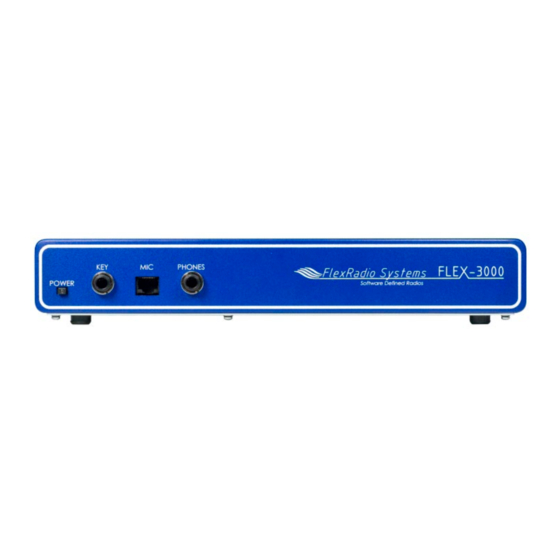Advertisement
Quick Links
product review
FlexRadio Systems
FLEX-3000 Software Defined
HF/50 MHz Transceiver
Reviewed by Steve Sant Andrea, AG1YK
Assistant Editor
The FLEX-3000 is a software defined
radio (SDR) that uses a minimum of hardware/
analog components to produce a working
HF/50 MHz, 100 W all mode transceiver. As
with previous FlexRadio offerings, the radio
is only a third of the actual system. It must be
combined with a computer and software.
The computer is a significant factor in
the purchase of a FLEX-3000, as the quality
of the computer greatly affects the overall
system performance. When considering the
FLEX-3000, check FlexRadio's Web site for
information on computer requirements. For
this review, the ARRL purchased a Dell In-
spiron 530 running an Intel Core 2 Quad CPU
at 2.83 GHz with 3 GB of RAM memory. The
operating system is Windows Vista 6.0.6001
SP1. An IEEE 1394 (FireWire) 400 MB/s in-
terface connects the computer to the radio.
Figure 1 — Rear panel connections are straightforward — dc power, antenna, computer,
amplified speakers, TR and amplifier switching and FlexWire I/O for accessories.
Mark J. Wilson, K1RO
The software, FlexRadio Systems Power
SDR, is freely downloadable from FlexRadio's
Web site. This is the same software used with
other FlexRadio transceivers we've reviewed.
It's regularly updated to improve performance
and add features — one of the big attractions
of an SDR.
Sibling Rivalry
The FLEX-3000 is the little brother of
the FLEX-5000, which QST reviewed last
1
year.
The '3000 has been designed as an
entry-level SDR for those who are curious
about how these radios actually "play" but
may not want to spend the additional $1000
or so for the advanced capabilities of the
FLEX-5000. It's also smaller and easier to
1
R. Lindquist, WW3DE, "FlexRadio Systems
FLEX-5000A HF/50 MHz Transceiver," QST,
Jul 2008, pp 39-45. QST Product Reviews
are available on the Web at www.arrl.org/
members-only/prodrev/.
Product Review Editor
Key Measurements
Summary
70
20
20 kHz Blocking Gain Compression (dB)
70
2
2 kHz Blocking Gain Compression (dB)
50
20
20 kHz 3rd-Order Dynamic Range (dB)
50
2
2 kHz 3rd-Order Dynamic Range (dB)
-40
20
20 kHz 3rd-Order Intercept (dBm)
-40
2
2 kHz 3rd-Order Intercept (dBm)
TX
-20
Transmit 3rd-Order IMD (dB)
-45
TX
-20
Transmit 9th-order IMD (dB)
PR040
Key:
Dynamic range and intercept
values with preamp off.
Intercept values were determined
using -97 dBm reference
*
Blocking level exceeds the threshold
of ADC clipping.
Bottom Line
The FLEX-3000 is a compact
software defined radio (SDR) in the
mid-range price class. It can be used
at home or paired with a notebook
computer for operation on the go.
Although it gives up some features
compared to the FLEX-5000A, it
doesn't give up much performance.
k1ro@arrl.org
From October 2009 QST © ARRL
111*
112*
140
111*
112*
140
101
97
110
95
110
29
28
+35
26
+35
-30
-35
-70
80 M
20 M
Advertisement

Summary of Contents for FlexRadio Systems FLEX-3000
- Page 1 The computer is a significant factor in year. The ’3000 has been designed as an the purchase of a FLEX-3000, as the quality Transmit 3rd-Order IMD (dB) entry-level SDR for those who are curious of the computer greatly affects the overall about how these radios actually “play”...
- Page 2 — a good match for a notebook computer. Flexradio FLeX-3000, serial number 1709-0037 The FLEX-3000 lacks some of the fan- Manufacturer’s Specifications Measured in the ARRL Lab cier bells and whistles of its larger kin, and the FlexRadio Web site has an extensive Frequency coverage: Receive, 0.03-65 MHz;...
- Page 3 Audio Mixer, which controls the audio inputs and outputs to the FLEX-3000. Manufacturer’s Specifications Measured in the ARRL Lab The Inevitable Upgrade Second-order dynamic range: Not specified. Preamp off/on: 14 MHz, +98/+78 dB; 52 MHz, +107/+93 dB.
-
Page 4: Frequency Control
0.04 0.06 0.08 Figure 3 — CW keying waveform for the FLEX-3000 showing the first two dits in full-break-in (QSK) mode using external keying. Equivalent keying speed is 60 WPM. The upper trace is the actual key closure; the lower trace is the RF envelope. - Page 5 VFO B, swap frequencies between A and B or to synchronize A and B. An additional Figure 6 — The FLEX-3000 is tiny compared to a desktop PC. It’s a natural for control, , is used when you shift the filter IF>V...
- Page 6 The button activates 100 kHz of spectrum. With SDR receivers, such as the FLEX-3000, the sample the Virtual Audio Cable, which is a third rate is set to the highest setting.
- Page 7 As seen in Figure 6, the FLEX-3000 takes sired sideband suppression than the ’5000A. Out of the box the FLEX-3000 is a very ef- a tiny amount of desk space, and the main The worst-case transmit intermodulation fective radio, but it is not quite plug-and-play.
- Page 8 We Reciprocal mixing, 14 MHz 20/5/2 kHz offset received and tested an updated FLEX-3000 Before, AGC on: Better than 112 dBc Before, AGC off: 91/90/89 dBc at the ARRL Laboratory shortly afterward.












Need help?
Do you have a question about the FLEX-3000 and is the answer not in the manual?
Questions and answers